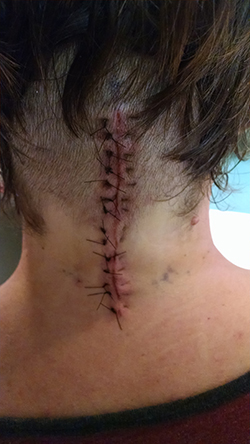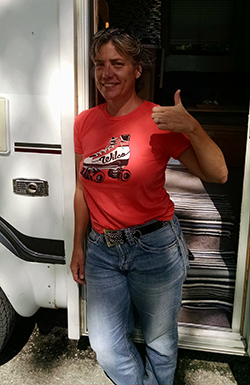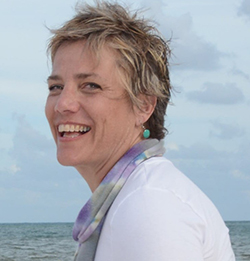A Story of Recovery from Spinal Cord Tumor Surgery

Name: Dawn S.
Type of Cancer: Grade II Ependymoma
Diagnosed: Age 45, 2011
By: Dawn
— Categories:
Adult
Spine
“The first thing I remember after surgery is being able to move my hands and feet and breathe on my own. I remember smiling. I was not paralyzed. My neurosurgeon later told me that I said, ‘I’m a rock star.’ I probably did. It sounds like something I would say.”
So begins Dawn’s recovery from a surgery that removed a spinal cord tumor located in what doctors refer to as “a high real estate area” of her spine—cervical levels 1 and 2, just below the brain. The tumor was a grade II ependymoma.
Adults with spinal cord tumors are exceedingly rare, and written accounts of what it’s like to survive tumor-removal surgery are even more rare. Dawn was told that things would be “different” after surgery, but she had no idea just how strange her sensory experiences would turn out to be.
Through writing the book, ReWired: A Story of Recovery from Spinal Cord Tumor Surgery, Dawn hopes to give those who are on a similar journey the reassurance that they are not alone. She not only offers a glimpse into what their post-surgical experience might be like, she also offers insights on how they might accept their body’s “new language” with curiosity, humor, gratitude and grace.
Here are three excerpts from her book.
 Day One
Day One
When I woke up from surgery, my body felt numb and I could not determine the outline of my body from my collarbone to my toes. It felt like my nerves were reaching beyond the boundary of my skin. The only parts of my body that felt normal were my shoulders and above. The strange thing about the numbness is that I could feel things—my body sensed touch—but it was not in the same way I had felt things before. I could feel the medical staff poke me with sharp vs. dull objects and could tell the difference between them, but it almost felt like it was happening to someone else’s body. Another way to describe it is that it felt like there was an energetic force field around my body and when people touched me it felt like they were touching the edges of the force field and not actually touching my body.
My whole body felt like it was floating off the bed, and it felt like my feet were on the ceiling and my head was on the bed—like I was standing on my head while lying in bed. It took all my concentration and energy to make peace with the sensory experience I was having. During those first couple of days I clung to my mantra: I am not going to feel like this forever.
At the same time, I was full of gratitude that the surgery was a success and that it looked like the tumor was completely removed. I was proud of my neurosurgeon, proud of myself for taking the risk and proud of my body for making it through the surgery successfully. I remember waking up from surgery, seeing my family standing next to my bed and I said, “I did it”. I guess that summed it up.
The experience of not being embodied was unlike anything I could have imagined. It felt like my nerves were trying to find a way home to my body; a body I could not feel. The image I had in my mind was of a million strings made of light reaching out from every part of my body, searching throughout the universe, as if they were seeking to make sense and order of this new circumstance. It’s hard to describe, but I felt boundless. It made me wonder if that is how we really would be if we didn’t have bodies.
 Day Four
Day Four
Now that I was able to sit up by myself, it was time to practice standing and walking. I did this with the help of my physical therapy (PT) team, a walker, and a gait belt that was cinched around me for safety. I could not feel my feet in contact with the floor. In fact, it felt like my feet were hovering about two feet above the floor. I stomped my feet, relying on my ears to tell me that my feet were in contact with the ground. My butt felt like it was way up in the air over my head, like a string pulled it up behind me. When I moved, it felt like my butt and legs were hovering over my head. I kept getting this image of the Macy’s Thanksgiving Day Parade balloons, and the way they float down the street. It was very distracting. I relied on my eyes to tell me that my butt was under my abdomen, verifying that I was, in fact, standing upright and not floating. But I could walk. I could tell it was going to be a long process until it felt or looked normal, but the worst had not happened, I was not paralyzed. I felt overwhelmed with gratitude.
Recovery Continues to Happen
The one-year anniversary of the surgery has now come and gone. The latest MRI shows that the tumor is gone and the surgical site is healing beautifully. When I wrote ReWired, I intended that it cover just the first ten months of my surgical recovery. But something has shifted in the last two months, and I felt it was too important—and hopeful—to leave out. What I want to tell you is that it keeps getting better. This recovery, this healing, continues to happen.
At the end of ten months, things were still kind of rough for me, and it felt like I was ending the book on a melancholy note. In the last month, however, my recovery turned a corner for the better. I am working more hours at my job at the hospital. I am doing more fun things because I have the energy to do them. I am cross-country skiing again, one of my favorite winter activities. Think about that for a minute—three months ago I could only ride a bike for ten minutes, and that was after I spent two months relearning how to ride it. We had our first decent snowfall of the season last week, so I decided to try skiing. Unlike my experiences with swimming and biking, I found I was able to ski without first having to relearn it. In fact, I skied as far, as fast, and as well as I had before the tumor diagnosis. I have to tell you that I was smiling so much during the ski that I got a “brain freeze” headache from the cold air swirling around in my sinuses!
This is important—healing continues. It keeps getting better. I keep getting better. One evening last week, while I was sitting on the couch, I suddenly realized that my body felt completely normal. I didn't have zinging sensations in my legs. No ball under my butt. No tight bands around my body. It was relaxing. It was hopeful. It was glorious. I told my husband, “I feel normal. Like I didn't have surgery.” Then I sat on the couch and smiled for an hour. Wow. If it can happen for an hour, it can happen again—and maybe for longer. I am living my life again in a fuller, more familiar way. Better now than in the past ten months. Better now than in the past few years, actually.
 I know that I would have liked a book like this when I was preparing for surgery. It likely would have given me equal doses of fear and hope. I give it to you now with the prayer that it helps you on your journey, whether you are living with a spinal cord tumor, loving someone who has one, or treating someone with one.
I know that I would have liked a book like this when I was preparing for surgery. It likely would have given me equal doses of fear and hope. I give it to you now with the prayer that it helps you on your journey, whether you are living with a spinal cord tumor, loving someone who has one, or treating someone with one.
To purchase, ReWired: A Story of Recovery from Spinal Cord Tumor Surgery, click here.
Facing Surgery
Dawn also presented at the 2015 Spinal Tumor Patient Education Conference at the MD Anderson Cancer Center, a participating CERN center. The talk not only chronicles Dawn’s journey of coping with the tumor and its symptoms, it also highlights her insights into the unique and difficult decision faced by spinal cord tumor patients about whether or not to have tumor-removal surgery.
Click here to view presentation.
Update: May 10, 2022
Dawn launched a new book that offers much-needed insight into the realities of a rare diagnosis called ReConnected: Stories of Spinal Cord Tumor Survivors. Reconnect: a powerful concept for those who have had a spinal cord tumor (SCT) diagnosis. After surgery patients strive for a reconnection between the central nervous system and their bodies. Her new book addresses an equally important type of reconnection: to other survivors. ReConnected: Stories of Spinal Cord Tumor Survivors is a collection of real-life stories from people who came through SCT diagnosis, surgery, and treatment to reconnect with themselves and others. The intimate realities of life after diagnosis and surgery are told in their own words.
The idea for this book came directly from connections Dawn made with her first book, ReWired. “After the book came out, readers reached out to me, looking for more information about surgical outcomes, or curious about what my life was like during the six years after surgery. I realized that the people I was meeting also had their own stories to tell.”
Dawn compiled first-person stories from nine SCT survivors and one healthcare worker. Together, the stories provide a multilayered view of how this complex condition affects each life differently. “My hope is that the wide-ranging experiences offered so generously here will help each reader find information, connection, and hope. The book also features Inspiration Stories from spinal cord tumor survivors from the CERN Foundation website.
